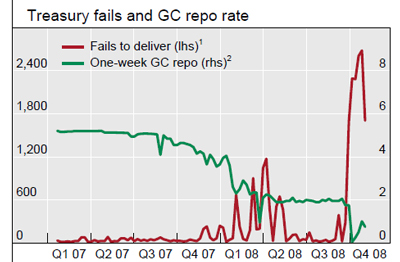The Bank for International Settlements has released its Quarterly Review, December 2008.
Articles include:
- Global financial crisis spurs unprecedented policy actions
- Highlights of international banking and financial market activity
- Developments in repo markets during the financial turmoil
- Commodity prices and inflation dynamics
- Bank health and lending to emerging markets
- How many in negative equity? The role of mortgage contract characteristics
Repos and the Treasury Market Practices Group were briefly mentioned on November 24. The following is from the BIS article on repos:
By March 2008, however, the financial turmoil reached a point where heightened risk aversion coupled with uncertainty over valuations of particularly risky products led participants in the repo market to abruptly stop accepting anything other than Treasury and agency collateral. As a result, investment banks such as Bear Stearns suddenly found themselves short of funding, as a large part of their collateral pool was no longer accepted by the US repo market. This change led to a sharp increase in the demand for government securities for repo transactions, which was compounded by significantly higher safe haven demand for US Treasuries and the increased unwillingness to lend such securities in repo transactions. As the crisis unfolded, this combination resulted in US government collateral becoming extremely scarce. As the available supply of Treasury collateral dropped, those market participants willing to lend out Treasuries were able to borrow cash at increasingly cheap rates. At times, this effect pushed US GC repo rates down to levels only a few basis points above zero.
The scarcity of US Treasuries for repo transactions also manifested itself in a sharp increase in the number of Treasury settlement fails. Whereas fails to deliver Treasuries had averaged around $90 billion per week during the two years preceding the crisis, they rose to above $1 trillion during the Bear Stearns episode and then soared to record highs of almost $2.7 trillion
following the Lehman default (Graph 5).
